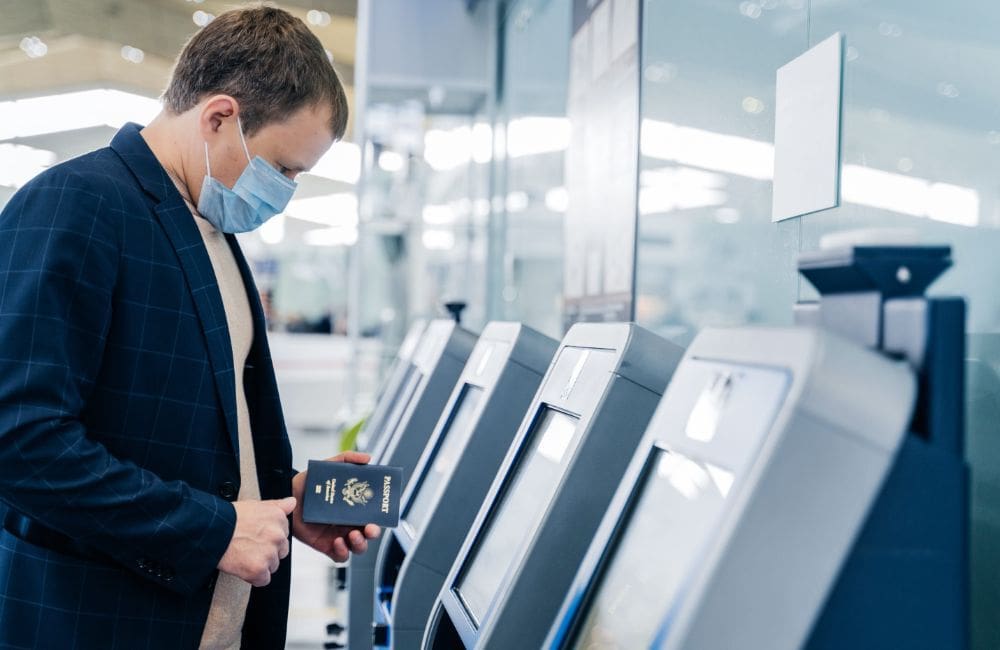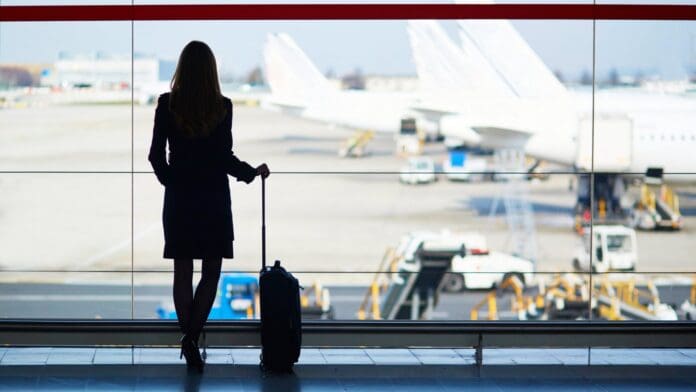Business travel came to a complete standstill when the pandemic hit—86% of people surveyed had to cancel all plans for international business travel in the wake of flight restrictions, lockdowns, and travel bans.
Even as the plummeting growth curve of the tourism and travel industry started improving in the latter half of the year, corporate travel remained relatively low throughout 2021 and stood at 10% of the pre-covid world.
In 2022, travel has finally started taking off, with 68% of business leaders and travel managers expecting to see business travel return to pre-pandemic levels over the next years.
As we gradually transition out of the pandemic, it’s time to reflect on how the pandemic affected the world of business and what lies ahead. So, we’ve compiled 50+ statistics that convey the impact of COVID-19 on corporate travel worldwide.
Projections for the future of business travel
The global market for business travel is showing signs of recovery and is projected to reach US$829.5 billion (ReportLinker). In Q2 of 2021, less than 1 in 5 companies reached 25% of their quarterly travel spend in 2019.
By Q4 of 2022, close to 9 in 10 companies expect to reach or cross 75% of their 2019 spending levels (Deloitte). In Q3 of 2021, US business travel spend was at 15-20% of the 2019 levels. By Q3 of 2022, nearly half the companies surveyed are projected to reach 25% of 2019 levels (Deloitte).
By Q4 of 2022, US business travel spend is projected to reach 65-80% of 2019 levels. This growth depends on external factors like public health situation, quarantine requirements, and rollout of COVID-19 vaccines in European and Middle-East countries (Deloitte). Research indicated a 26% growth in international business travel expenditure in 2021. Forecasts expect this figure to increase by 34% in 2022, leading to a total increase of 60% in global business travel expenditure (WTTC).
Annual business travel spending is expected to slow in 2023 but will pick up to nearly hit pre-pandemic levels by the end of 2024 with $1.4trillion in spending (GBTA). Research suggests that smaller companies will resume business travel at a faster rate than their bigger counterparts due to the projected expenses (Deloitte).
Sales trips are one of the biggest drivers for the return of international travel. 43% of companies are sending employees abroad for sales trips. This is followed by leadership meetings (32%) and client work (31%). Business conferences stood in fourth place with only 15% of companies willing to make an overseas trip to attend a conference (Deloitte).
How is the return to business travel affecting employers and employees?
Business travel is bouncing back, with 85% of US companies planning corporate trips in April 2022—a 20% increase since January (GBTA).
93% of surveyed companies are aiming to permanently change remote work and meeting policies.
66% of companies are expected to permanently change travel policies (BCG).
86% of the total 400 business workers surveyed stated that travel is an essential part of their work and they have to travel to fulfill their goals (BTI Outlook).
More than half of the employees surveyed responded positively about business travel and hoped to travel more often. 43% of respondents did not mind traveling for work (BTI Outlook). More than 50% of travel managers are planning to reduce travel budgets to offer more flexibility for remote roles (BCG).
Two of the biggest reasons behind the slow return of business travel are resistance from employees and clients towards traveling and in-person meetings (Deloitte). March 2022 witnessed a significant streak of recovery during which business travel spending was only 5% below 2019 levels (USTA).

Eight out of 10 travel managers expect changes in company travel policies following the pandemic, such as increased approval requirements and additional evaluation criteria (USTA). At least 50% of surveyed companies reviewed their business travel policies to accommodate the changes caused by the pandemic (TravelPerk).
Three of the biggest concerns for travel companies and managers overseeing the return of corporate travel are: Changing or canceling flights with ease (70%) Accessing security fast lanes (69%) Maintaining social distancing (66%) (McKinsey) When asked about the importance of business travel for their companies, CFOs tended to mention the return on investment in relation to Sales and business development (68%).
Internal strategy and business planning (50%) Client account management (48%), and development for employees (48%) (BTI Outlook) 48% of business executives surveyed believe business travel spending will return to pre-coronavirus levels in the next two or three years (CNBC).
Business executives in the Asia-Pacific region are the most optimistic about the return of corporate international travel with 53.8% claiming it’ll be back to 2019 levels by 2025 (CNBC). 94% of companies changed their travel policy to prevent employees from traveling during the pandemic (CITI).
68% of employees surveyed claimed that they were unsure of when their companies would allow attending large conferences and offline events. 49% of employees mentioned that they were uncertain of when their organization would resume travel altogether (CITI). Travel managers put their company’s travel expenditure at an average of 33% of the pre-pandemic level. Providers for business travel claimed this number to be at 42% of the pre-pandemic levels (GBTA).
64% of workers consider offline, in-person meetings as a critical part of building a healthy business relationship. 53% trust salespeople more in offline situations than online (TravelPerk).
74% of workers disagree with the notion that face-to-face meetings are a thing of the past (TravelPerk). Flexible work options will increase the need for business travel with remote workers reporting to the company headquarters and business retreats every once in a while. Two-thirds of the companies are willing to reimburse trips and relocation for their employees.
29% of them ask employees to bear the costs while the remaining have not defined their policies yet (Deloitte). Companies with more in-office employees than work-from-home employees are twice as likely to reach 2019 levels in their travel spending by 2023. Only over one-third of WFH-dominant companies expect to reach 2019 levels by 2023 (Deloitte).
Accommodation and transportation are bouncing back
Before the pandemic, international travel for business accounted for 70% of the total revenue for high-end hotel chains (WTTC). The top 10-15% of customers for global airlines contributed 40% of their revenue. So, the slowdown of business travel disproportionately impacted the airline industry hard (WSJ). Business travelers made up 12% of the total flyers pre-COVID and were responsible for 55-75% of the total profits for airlines (WTTC).
Reports suggest that revenue per available room will not reach 2019 levels at least until 2024. The top priority for hotel owners is to maintain the quality of service and sustain themselves financially (STR).
53% of travel managers believe that air travel bookings through online travel agencies will reduce in 2022 when compared to 2019 levels (WTTC).

40% of respondents believe direct bookings through airline websites will remain the same in 2022 when compared to 2019 (WTTC).
Continuous improvements in air demand took the growth of the airline industry to just 12% under 2019 levels in April 2022, creating a record high in the new normal world (TSA).
61% of business travelers include some leisure travel in their trips while 41% extend their business trips to indulge in a vacation (BCG). Air travel demand recovery isn’t expected to reach pre-pandemic levels globally until 2024. The Asia-Pacific region is expected to drive this recovery followed by Europe and North America (McKinsey).
From journeys under 100 miles within the US to foreign trips, workers traveled via car more than airlines in 2020 (McKinsey). Rail transport has shown far better recovery than air travel in the context of corporate travel. This is evident by the fact that 80% of domestic business travel is via rail (TravelPerk).
The average cost of a roundtrip is estimated at $330 in 2022, which is significantly higher than $235 in 2019 (Travel Pulse). Seven in 10 companies are willing to limit travel frequency to cut costs. More than one-third of travel managers expect to minimize travel spending by working with economical providers (Deloitte). 36% of workers are planning to fly less to reduce their environmental impact. This figure has increased by 5% since 2019 (McKinsey).
Companies are increasingly working towards boosting compliance and delivering duty of care through corporate booking channels. 45% of respondents believe that lodging bookings via company-approved booking platforms have increased in 2022 when compared to 2019 (Deloitte). Only 9% of companies include alternative lodging options in their corporate booking policies. Just above one-third (34%) of companies are willing to reimburse employees for non-hotel lodgings (Deloitte).
Sustainability turning the tide for business travel
The pause in commuting and global business travel during the pandemic reduced carbon emissions by 7%, a 2.6 billion ton reduction in carbon dioxide (NBC). Almost 33% of travel managers stated that their organization has a goal of reducing carbon emissions by a defined margin within a specific timeline. 79% of companies surveyed have pledged a reduction in carbon emissions in their travel policies (Deloitte).
50% of companies surveyed have prioritized sustainable travel over other factors since 2020. Climate considerations for corporate trips are now a critical part of an organization’s sustainability plans (BCG). 48% of companies in the survey want to prioritize the socio-environmental impact of business travel.
25% of organizations place the socio-environmental impact of business travel within their first three priorities (GBTA Emburse). Six out of 10 companies follow broader sustainability initiatives. However, business travel is a part of the sustainability plan in only three out of 10 organizations (GBTA Emburse). 19% of surveyed companies encourage sustainable accommodation and transport options, but only 7% of companies incentivize employees to pick sustainable options (GBTA Emburse).
74% of companies in the mid-range of annual travel spend ($10-30 million) are measuring the carbon footprint of all travel compared to only 54% of companies in the higher range of travel spend (more than $30 million) (GBTA Emburse). 29% of companies in the mid-range of annual travel spend ($10-30 million) are using carbon footprint data to make more environmentally conscious travel booking decisions. Only 15% of companies in the higher range of travel spend are doing the same (GBTA Emburse).
43% of companies consider sustainability ‘somewhat important’ when choosing travel products and partners. Only 9% of companies rate sustainability as ‘very important’ in their decision (GBTA Emburse). 85% of companies are not ready to pay more for sustainable travel partners—a mere 2% are willing to pay extra for sustainable travel options (GBTA Emburse).
Three in five companies face tough questions from employees regarding their sustainable travel policies with 64% of businesses developing a clear policy to minimize environmental impact through corporate trips (BTN). 71% of workers state that businesses not offering sustainable travel options set a bad example for future generations (Trainline). One in five 16-24-year-olds surveyed reported they would leave a job where the employer did not follow a sustainable travel policy (Trainline).

64% of surveyed companies offer more eco-friendly and sustainable travel options in comparison with the pre-pandemic travel options. (Trainline) 45% of companies lacking a strong and clear policy for sustainable travel have struggled to hire staff following the pandemic. (Trainline) 89% of business leaders agree that sustainable travel initiatives or policies are critical to their employer branding efforts (Trainline). Sustainable objectives will potentially limit the growth of corporate travel. Three in 10 companies are expecting that their sustainable initiatives will reduce their travel spending by 11-25% in 2025 (Deloitte).
Business travel is back
Business travel is bouncing back stronger than ever. With positive signs visible in companies across the world, the industry is expected to reach and surpass pre-pandemic levels. It’s no surprise, that after so many years of being bound to digital offices from uncomfortable sofas people are itching to get business on the go once more.
Business travel has changed for good, with travelers now demanding more flexible and sustainable options than they did before the pandemic. TravelPerk can provide just that, and so much more.
Try TravelPerk today to experience business travel made easy, and enjoy the ample solutions on offer for corporate travel. Let’s see where TravelPerk can take you.
The post Impact of COVID-19 on business travel: 50+ post-pandemic stats appeared first on TravelPerk. For more on travel.


